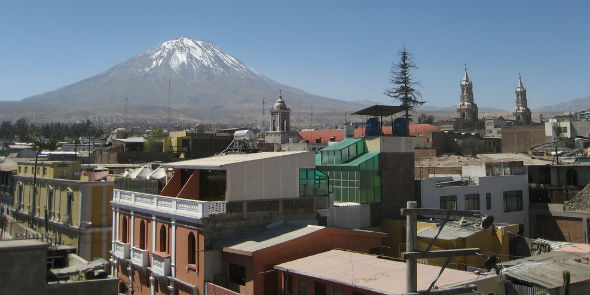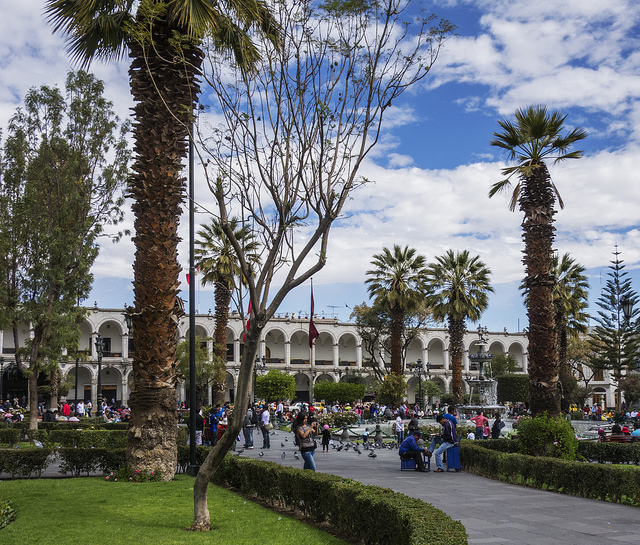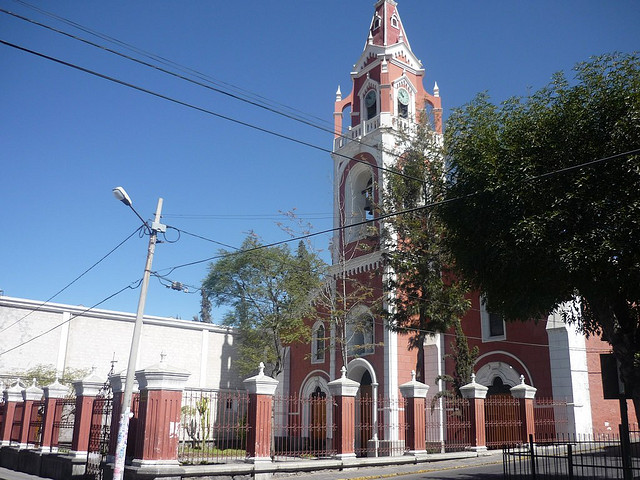Why did I need to travel all the way to Arequipa, in southern Peru, to write about my life in New York? I have to admit that it was more an excuse to get away from brutal winter and demanding clients, an excuse to explore a new continent’s magical villages and rugged terrain, and finally, an excuse to have no excuse for not writing.

Arequipa City Roofs (Photo: Will Russell)
I wanted to find the kind of writer’s haven I had always dreamed about. Jack Kerouac found inspiration on the road in Mexico. Mark Twain wrote while floating down the Mississippi River. Emily Dickinson had her quaint cottage in Massachusetts called “The Homestead.” And now I would have the land of eternal sun to claim as my geographic muse.
I opted to kick off my ten-week sojourn with two weeks of intensive Spanish classes so that I could communicate beyond the few phrases I remembered from junior high Spanish—and arranged to live with a local family. When I arrived from the airport, I checked into my private room in a charming little hotel, Casa de Avila. All of the rooms faced a grassy inner garden, ruled by a large tortoise who spent his days relaxing under clusters of wildflowers. I had searched on-line for the perfect place, and rather than choosing by location, amenities, or cleanliness, settled on “the place with the turtle.” Fortunately it also housed a well-run Spanish school that offered family placement and private lessons in the garden. I settled into my room, and then headed out to explore the town, the second largest city in Peru.
As I walked toward the town’s center, gritty traffic fumes and black exhaust poured out of old beat up cars and buses adding a grey film to rather non-descript buildings. The people, in contrast, were in vivid color. The streets were packed with local businessmen returning home from work intermixed with indigenous peoples—direct descendants of the Incas, who were selling cigarettes, herbs and spices. They wore traditional costumes: bright heavy skirts heavy with embroidery, complete with little bolero hats—and not for the sake of the tourists, of which there were few.
Bus drivers loudly chanted their destinations as they drove by, trying to out-shout each other and lure people on to their bus. When someone was interested in boarding, the bus would roll by making no pretense of stopping, and several people would grab the new passenger, pulling him into the already crowded bus.
Intersections were just a series of me-first honks and drivers shouting from windows, negotiating in no uncertain terms who will have the right away. In order to cross the street I soon learned to scoot up to a group of Peruvians and surround myself in a human shield, walking when they walked, stopping short when they stopped. As I weaved through the streets, someone shouted CINTAS de los ZaPAAATOOOS in a repeateding loop. I turned to see what at first glance looked like a hairy monster but was actually a man selling shoelaces; piled high on his shoulders, he was buried in them with just his nose and eyes popping out. I finally made my way to La Plaza del Armas, the old colonial town square, built entirely out of white igneous rock all aglow in the setting sun. From there, I could just catch a glimpse of Misty, the tallest of the three towering volcanoes that have surrounded the city since ancient times.

La Plaza de Armas. (Photo: A.Davey)
The following morning I headed back to La Plaza and happened upon a large parade, giving me a warm welcome. I had breakfast on a balcony overlooking the square, watched the festivities and chatted in broken Spanglish with locals who explained that it was political in nature having to do with farmers unions. It was fantastic fun as colorful groups marched and danced, their dazzling dress and hat styles differentiating their tribes. Some of the marching military troops stopped in the center of the square, where a lone soldier belted out something operatic. It was magical.
The family stay was arranged on my third day and I was packed, standing by the curb of my hotel, nervously fidgeting with my backpack. I dressed in my best travel sundress but was concerned that they might be surprised to be “adopting” a thirty-four-year-old woman.
When Charo, my new “mom,” bustled through the gate, I liked her energy; she had a husky voice and a loud throaty laugh. When we got to the car I met some of my other new family members: her son, Edson, a sweet, pudgy boy, and Jonathan, my new and unarguably good-looking “brother” who was also studying Spanish—he was a 26-year-old from Seattle who had already been with the family for a week.
During dinner I met my “dad,” Pepe, a middle-aged man with deep laugh lines. I tried to make a good impression but it was a struggle—I only knew a few sentences, and otherwise had to meet them with a simple smile. If I asked any question, no matter how straightforward, I wouldn’t get the one word answer I needed, but a response so long-winded—that the keyword I was looking for—wasn’t even recognizable. Jonathan helped me struggle through broken Spanish and we chatted later that night in English.
Their home was a tranquil place for a writer—from the roof you could see all three of the mystical mountains as well as the towers on the cathedral in town. Charo led me to my room, explaining that it belonged to her daughter who was away on vacation. When she opened the door, I was greeted by about 200 pairs of eyes. Dolls of every shape and size peered at me from all angles. A shelf stuffed with the freaky figures went around the top of the room in its entirety. A larger than life baby doll sat like a guard to the left of my bed. Fancily-dressed dolls from every country loomed above my headboard. I decided to call my writer’s haven “The Dollhouse.”
The next day I had my first four-hour Spanish session. For some reason, I’d always assumed that knowledge of fluent Spanish was locked away somewhere deep inside me and that it would suddenly be recalled from the recesses of my memory. Unfortunately that wasn’t the case. The teachers used the total immersion method, speaking only in Spanish, which didn’t help matters.
My first day went well enough, and Jonathan and I walked the three miles home together, crossing the bridge over the mighty Rio Chile, the sun warm on the back of my neck. I felt like a schoolgirl again, kicking stones along and balancing on the railroad tracks. We arrived to a three-course lunch served to us complete with fresh avocado salad and lomo saltado: a spicey beef stir-fry. We drank chicha, a fresh, sweet local drink made with corn.
I tried to speak more Spanish at dinner that night. It would take me about five minutes to form the sentence, like “I like your sofa” in my head. That would be my contribution while I formulated another phrase with no regard to the conversation around me. I was throwing out any sentence in which I could pull together a noun and a verb. “I have a yellow hat in my bag,” I said. “I like to ride the bus.”
Being totally immersed in the classes was challenging and the family routines were rigid. We rose at 6:00 a.m., had class in the mornings, then ate lunch together, their largest meal of the day. I wrote with my dolls in the afternoon, and finally we had tea time at around 10 p.m. Jonathan and I began to go out and explore the town after school or on some evenings to get away and check out the nightlife.
One such afternoon we went to the old town, with its 14 churches, four chapels, and eight convents and monasteries. We wandered through open air markets, bought ice cream from a street vendor and shopped in high-end gift shops, walking through a maze of semi-circular arches and vaulted ceilings. Alpaca wool—much softer than sheep wool—is their main industry and export, and the colorful blankets, woven and embroidered fabrics were a feast for the eyes. I bought a gorgeous green alpaca scarf and matching woolen hat with long tassels.

Monasterio de la Recoleta. (Photo: Jerry L via Flickr)
Alpaca was also sold on menus in the form of steak. It is a delicacy passed down from the Incas, along with another traditional dish—grilled guinea pig. Called coy, the rodents were once eaten by Incan royalty. In fact, in the Cusco Cathedral there is a very famous replica painting of DaVinci’s the Last Supper featuring Jesus and his twelve disciples seated around the delicacy served on a platter. It’s wonderfully quirky and we contemplated trying the dish.
I had seen pictures on menus and the guinea pig is served whole, on its back with legs spread wide on the plate looking more like a flying squirrel who crash landed. However the head is unmistakably rat-like, making it difficult for this New Yorker to swallow. Yet Jonathan and I researched restaurants and decided to give it a go, choosing Zingaro in the town’s center. Even though the main courses were only $10 to $20, the cost of living and eating in Arequipa is roughly 1/8 of that of the States, making it a splurge for us on a backpacker’s budget.
We thoroughly enjoyed our dining experience. The waitress asked us whether we wanted our entrees “with or without hair.” The cuy tasted gamey, a bit like rabbit, and the meat was not bad but there wasn’t a lot of it. Even without the hair, the skin was quite tough and rubbery, and there was a lot of it. Still we were glad to have conquered the cuy.
Another night we went out with a few fellow students to an Irish bar, located in an alleyway just behind the cathedral, Paseo de la Catedral, a popular walking street with lots of nightlife. I’ve found that no matter where you are in the world and how far off the beaten path, there will always be an Irish bar, always friendly and always playing U2. We chatted, played pool and drank super-sized Crystal and Arequipena beer. Afterwards, we went clubbing, meeting young locals who were friendly towards foreigners, eager to practice their English.
Toward the end of my stay, I took my favorite teacher to a local wine bar, Montreal Le Café Art, not far a from the school, where we enjoyed wine and the ambiance—like many of the bars the architecture is colonial, and ancient, and we sat under deep vaulted ceilings surrounded by artifacts and local art.
In fact, classes had been great, professionally run with a knowledgeable, patient, staff. At school I was learning more vocabulary words—but it seemed like the new ones were encroaching on the old ones and smothering them out, so that my Spanish was actually getting worse. By the second week I grew frustrated that my speaking wasn’t getting any better, making it challenging at home to keep up with the conversations, and exhausting me after early mornings, hours of classes, writing and sightseeing.
At home, we all ate lunch together as usual, where we were served more localities, like quinoa soup, rocotos rellenos, ceviche and plenty of potato dishes. Though Charo and Pepe had been good hosts, Jonathan and I were finding reliving our second childhood pretty overwhelming, with all the routines and necessary politeness, both being single and used to living on our own. We decided, at the end of two weeks, it was time to leave.
Though we appreciated the experience, we were ready to get out of the city and be surrounded by nature at its most majestic. Holed up in Jonathan’s room, we planned a three-day hiking trek down Colca Canyon, the second deepest in the world.
I packed up and left “The Dollhouse.” We hugged Charo and Pepe goodbye. When we got on the bus to the canyon, the excitement of our upcoming adventure was incredibly freeing. My speech was somehow freed up as well. I ordered coffee the way I like it, bought tickets for the bus, and picked up fruit at the market. The family stay had been worthwhile, and Arequipa was a great jumping off point for exploring Peru.
The trek down the canyon was awe-inspring and became on of my greatest travel accomplishments. From there I would continue on to the small town of Puno and explore the floating islands of Lake Titicaca, made entirely of reeds, which had to be seen to be believed. I would spend the night with an indigenous family on one of the islands, which would become a favorite memory. And finally I would relax for a week in charming, picturesque Cusco, a World Heritage Site, and then hike around the Machu Picchu ruins.
I no longer wished for a sanctuary in which to write, blocked off from the world. I wanted to get out into the world, to observe it and be absorbed by it. After all, it’s not where you are, it’s the experiences you have—and what you will take away—that make for a good story.